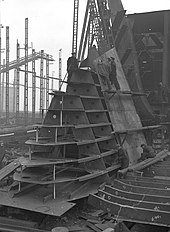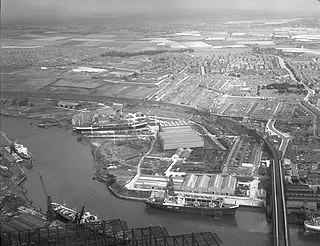
Bartram & Sons was a shipbuilder on Wearside, North East England, that specialised in building cargo ships. It was founded in 1837, taken over in 1968, nationalised in 1977 and closed in 1978.

Bartram & Sons was a shipbuilder on Wearside, North East England, that specialised in building cargo ships. It was founded in 1837, taken over in 1968, nationalised in 1977 and closed in 1978.
George Bartram and John Lister founded the business in Hylton in 1837–38. In 1852–54 their partnership was dissolved and Bartram's son Robert Appleby Bartram was taken into the business. [1]
On his father's retirement in 1871, Robert went into partnership with George Haswell as Bartram, Haswell and Company and they moved the business to South Dock in Sunderland. They began to build iron-hulled ships and in 1876 they built their last sailing ship, a four-masted barque. [1]

In 1889 Haswell retired, Robert Appleby Bartram's sons, George and William, joined the firm and the name was changed to Bartram & Sons. Between 1902 and 1914 it built 10 cargo liners for Ben Line. In 1914 it employed 600 people. [1]
In the First World War the company built ships mostly to private order, but including 10 tramp ships to the Shipping Controller's standard "War B" design [1] for 5,030 GRT ships 412 ft (126 m) long and 52 ft (16 m) beam. [2]
In 1922 the firm became a limited company. George's sons, Robert Appleby Bartram and George Hylton Bartram took over in 1925. From 1921 to 1930 Bartram's built at least 17 tramp steamers. [1]
The Great Depression that began in 1929 caused a worldwide slump in shipping. Bartram & Sons completed its last order in September 1930 and had no more for six years. In that time it built only one ship, the 3,829 GRT Eskdene. [3] That was a speculative venture in 1934, without an order, to create work for the yard. [1]
In 1935 the UK Government introduced a "scrap and build" scheme to encourage shipowners to order new ships and sell old ones for scrap. Evans and Reid of Cardiff ordered two tramp ships from Palmer & Sons, Nailsea Court [4] and Nailsea Meadow, [5] which were launched in 1936. Further orders from Evan Thomas, Radcliffe and Company, [6] [7] Evans and Reid [8] [9] and others kept Bartram & Sons in production until November 1938, [10] when it again ran out of orders. [1]
The Second World War revived demand and in November 1939 Bartram & Sons launched the first of a series of tramp ships to replace tonnage lost to enemy action. In the war the company built 24 cargo ships, 18 of them to standard Ministry of War Transport designs. [1]
The enlistment of men in the armed forces forced civilian employers to admit women to jobs that only men had been allowed to do. In 1943 Bartram & Sons employed its first woman welder, a Mrs Collard. [1]

Bartram and Sons remained productive after the Second World War, and many of its ships were exported to overseas buyers. In 1952 its South Dock yard was enlarged and one of its berths was extended. In 1961 it had 1,200 employees and in 1964 it took over the fitting-out quay of Short Brothers' yard at Pallion. [1]
In 1965 the Geddes Report recommended that Bartram and Sons should merge with other shipbuilders. [1] In 1968 Austin and Pickersgill (A&P) took over Palmer & Sons. In 1977 A&P was nationalised. In 1978 A&P closed Bartram's shipyard and moved all work to its own yard at Southwick. [1]
White's Marine Engineering Company was a British marine engineering company in Hebburn on Tyneside, that made marine steam engines in the 1930s.

William Doxford & Sons Ltd, often referred to simply as Doxford, was a British shipbuilding and marine engineering company.

Austin & Pickersgill is a shipbuilding company formed in Sunderland in 1954.

Short Brothers Limited was a British shipbuilding company formed in 1850 and based at Pallion, Sunderland since 1869. The company closed in 1964 when it failed to invest to build bigger ships.
Colonel Robert Appleby Bartram, MC, TD, DL was a British soldier and shipbuilder.
Sir Robert Appleby Bartram, JP was a British shipbuilder.
Clelands Shipbuilding Company was a leading British shipbuilding company. The Company was based in Wallsend was nationalised by the British Government. It was founded in 1864 by John and Thomas Cleland, and operated until it was acquired by Swan Hunter & Wigham Richardson in 1967. The company built a variety of ships, including passenger ships, cargo ships, and naval vessels.

Evan Thomas, Radcliffe and Company was one of the more prosperous and better-known of Cardiff-based shipowning companies, established in 1882 by a Ceredigion sea captain, Evan Thomas, and a Merthyr Tydfil businessman, Henry Radcliffe. Until 1939 one of the main trades of the company was to carry Welsh steam coal, which reached its peak in the years immediately before World War I. The company was ceased trading in the 1980s.
The Furness Shipbuilding Company was a shipbuilding company in Haverton Hill, Stockton on Tees, England. It was established during the First World War and operated from 1917 until 1979.

The Burntisland Shipbuilding Company was a shipbuilder and repairer in Burntisland, Fife, Scotland that was founded in 1918. In 1969 it was taken over by Robb-Caledon Shipbuilders, which in turn was nationalised in 1977 as part of British Shipbuilders.
William Gray & Company Ltd. was a British shipbuilding company located in West Hartlepool, County Durham, in North East England. Founded in 1863 by John Denton and William Gray as a partnership, it became a private and then a public limited company under the leadership of three generations of the Gray family until finally wound up in 1962.
SS Nailsea Meadow was a UK cargo steamship. She was launched in 1936 in Sunderland, England, and sunk by a U-boat in the Indian Ocean in 1943.
SS Nailsea Court was a UK cargo steamship. She was launched in 1936 in Sunderland, England. She was named after Nailsea Court in Somerset, England, which is an historic Elizabethan manor house. A U-boat sank her in the North Atlantic in March 1943. 45 men died and only four survived.
SS Agios Georgios IV was a Greek-owned cargo steamship that was built in England in 1938 and sunk by a Japanese submarine in the Indian Ocean in 1942. Agios Georgios IV was one of a relatively small number of steamships that had White combination engines. This was a combination of a high-speed four-cylinder compound steam engine that drove the propeller shaft via single-reduction gearing, with an exhaust steam turbine that drove the same shaft via double-reduction gearing.